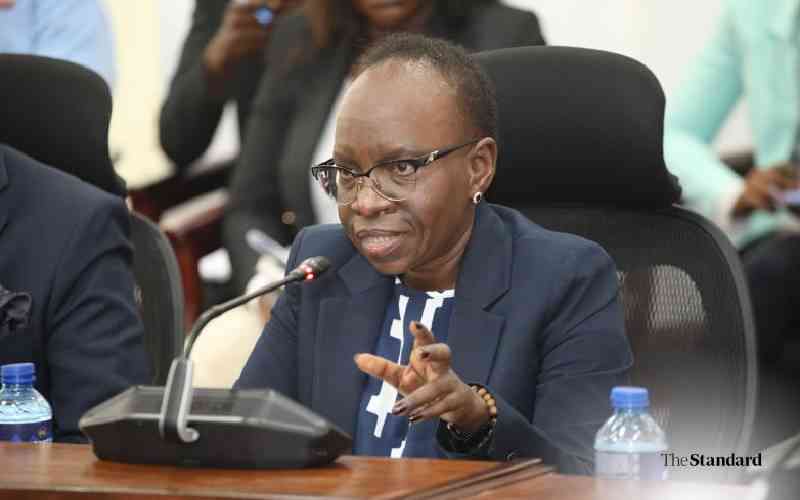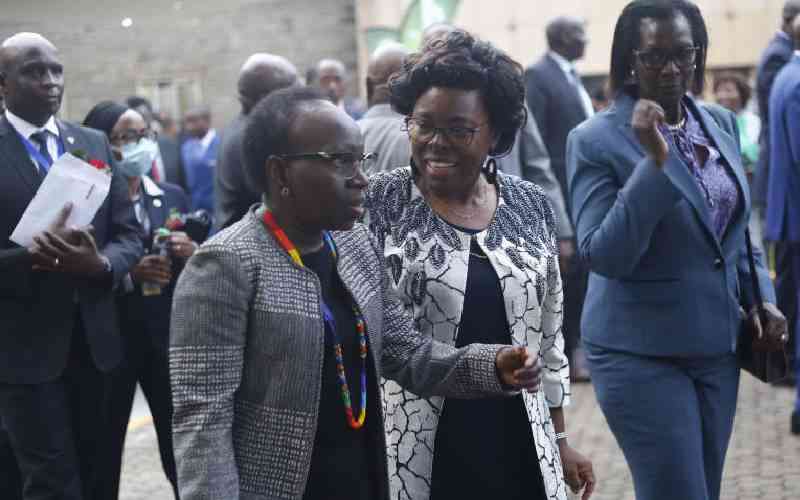
All is not well at the Youth Fund.
In 2007, a special kitty, the Youth Enterprise Development Fund (YEDF) was launched, promising the best financial services to the country’s millions of youth desperate for seed capital for their upstarts.
The fund was meant to create employment opportunities for young people through entrepreneurship and encouraging them to be job creators rather than job seekers.
The kitty was also meant to provide easy and affordable financial and business development support services to youth keen on starting or expanding businesses.
It was largely seen as an answer to the needs of the country’s growing youth unemployment.
But years later, the revolving fund that has cumulatively disbursed Sh12.8 billion to 1.15 million youth-led businesses appears to be benefiting everyone else other than youth-led entities that informed its formation.
Out of the credit, Sh7.8 billion was advanced through on-lending and leverage agreements with financial intermediaries while Sh4.7 billion was disbursed directly by the State agency.
The fund is now battling poor financial health. It has since amassed billions of shillings in bad debt and there are red flags in the way it is managed by those who eke out their living operating the multi-billion shillings account.
The management is currently at war with employees, adding to the never-ending feuds at the fund.
There are also claims of low disbursement of loans and lower recovery of the debts. In the latest rivalry, an all-out war between employees and the fund’s management now threatens to tear down the institution.
New structure
The staff accuse the chief executive of running down the organisation.
In an appeal to the Cabinet Secretary for Public Service, Youth and Gender Affairs Margaret Kobia, the employees expressed concerns that the CEO, Josiah Moriasi will run down the fund by implementing a new structure that has negatively impacted on staff morale.
They also accuse him of absenteeism from work as well as overseeing an era of extremely low disbursements and at the same time laxity in recovery of loans.
Stay informed. Subscribe to our newsletter
The CEO is also accused of refusing to settle salary arrears even though the award had been approved by the Salaries and Remuneration Commission (SRC).
This is even as the entity stares at a possible loss of more than Sh500 million to banks and other financial institutions, who insiders say have employed clever tactics to avoid repaying loans they secured from the fund for on-lending to youth-owned enterprises.
There are also doubts by the Auditor General that the fund may not recover the money owed by the banks.
The fund is no stranger to controversy. Since its inception in 2007, it has seen its share of management teams and directors, who for several reasons could not finish their terms.
Some of the former managers and board members have ended up in court on accusations of graft and abuse of office.
The legacy of bad blood at the fund appears to be taking a new direction. While it has previously been the board against management, this time it is the management versus employees.
The implementation of a new organisational structure that started in September is the bone of contention, with employees levelling all manner of accusations on the management, and specifically the chief executive.
“A general analysis of the current Youth Enterprise Development Fund (YEDF) salary scale structure reveals a salary structure that is subjective, out-rightly unfair and punitive to some job grades,” says a letter by the employees to the Principal Secretary for Youth Affairs and copied to the CS.
“The structure was a good idea. However, the implementation has been overtaken by the self-interest of the CEO to preserve his seat and continue doing as he pleases,” read the letter.
The employees appear to get the rare backing of the human resource manager, who in a letter to the chief executive dated October 14, 2019 noted: “It is my humble advice that the current process of conversion is revisited… the procedure in no way should harbour discriminatory insinuations let alone confirmed incidences. Where communication already released falls short of the above expectations, such communication should be recalled and adjusted accordingly,” said the human resource manager, Truphena Omung’ala.
The chief executive, however, defends the new structure and its implementation, arguing that it was developed by the Directorate of Public Service Management, a State department in the Ministry of Public Service.
It was also approved by the State Corporations Advisory Committee, while the employee salaries, according to Moriasi, had been approved by the SRC.
“Everyone has gotten an additional income, the new structure offers an advantage to every employee as well as the organisation. Every staff has been properly considered. What we have are few disgruntled staff who want to distract us from implementing it,” he said in response the employees’ letter.
Moriasi argued that the old structure had misplaced some staff. “So they are bitter because they think that if they had been properly placed in 2011, they would have grown to other levels by now.”
He noted that the fund did not have an organisational structure from inception. “We have developed one now and gone through all approval levels from different government agencies.”
Moriasi disagrees with his human resource manager, perhaps an indicator of the turf wars at the fund, noting that “the same HR was in place in 2011 when the mistakes that we are addressing now were committed”.
He adds that the fund is on course to advance Sh600 million as loans this year, surpassing last year’s Sh509 million.
But despite the high expectations, the kitty is staring at a loss of upwards of Sh500 million after several financial intermediaries it had advanced money for onward lending defaulted on repayments.
The intermediaries, which included Saccos and microfinance institutions, would regularly skip their repayments. They would also contest penalties after they failed to repay the cash as per the deal signed with the fund.
The likely loss brings out the other side of governance issues where other than boards and management teams trying to oust each other, there are instances where there is loss of taxpayers money. It is also another of those State entities that sign off lopsided deals with private enterprises whose benefits favour the private sector at the expense of the taxpayer.
The fund in a recent report noted that in the financial year to June 2016, it was seeing a loan repayment rate of 58 per cent, translating to a default rate of 42 per cent. This default rate is way above that of the banking industry, which currently stands at about five per cent.
The fund’s previous board, whose tenure ended mid this year, in an exit report noted that the repayments compared poorly with the industry trends.
It blamed financial intermediaries for failure to service loans advanced to them. “The loan repayment rate, at 58 per cent (in 2016), was far below the industry standard of 95 per cent. This was as a result of a high default, especially from financial intermediaries,” said the board then chaired by Ronald Osumba.
The report severally cites ‘high default’, especially from financial intermediaries as an issue of concern, notwithstanding the board’s insistence that its tenure had been a success.
The board appears to have done little to recover the funds. According to the Auditor General’s reports, the Youth Fund is unlikely to recover the money.
Former Auditor General Edward Ouko in a past report noted how the financial institutions were unbothered by the fund’s demands that they pay penalties for delays, but years later, none of the entities had paid, prompting Ouko to note that the chances of “recoverability is doubtful.”
The penalties at more than Sh200 million had over time risen to a point that they are now more than the principal amount that had been advanced.
“It is, however, evident that there has been no settlement of default penalty account by any financial intermediary since the inception of the fund. The amount has been building up over the years to the extent that the default penalty balance is higher than the loan balance from financial intermediaries of Sh168.26 million as of June 30, 2016,” said the Auditor General.
The fund is currently fighting it out in court with Rafiki Microfinance Bank and IndoAfrica, trying to recover more than Sh250 million that the two entities were advanced for onward lending to youth enterprises. It sued Rafiki to recover Sh100 million, which had been advanced for onward lending but is yet to be refunded.
In the case of Indo Africa, a financial institution that focuses on low-income areas, it is alleged the bank diverted the cash – Sh150 million – that was meant to be advanced to young people running businesses. “When the intermediaries were there, the disbursements were high but we are in court with those institutions because they cannot repay.
There is evidence that games were being played and most likely the repayment is in doubt,” said Moriasi.
The Youth Fund boss noted that the Sh500 million that the banks owe in principal and interest is a substantial amount considering that the fund has a capital of Sh3.8 billion allocated by Treasury over the financial years for lending to youth enterprises.
“This is what informed the board to stop the business with the financial intermediaries. We are currently dealing with the youth directly and we are doing very well. We have partnered with other youth-serving government organisations so that we coordinate with CDF officers and the sub-county youth officers – the ministry has offices in all sub-counties,” said Moriasi.
The fund also had to endure frustrations from financial institutions including some of the tier-one commercial banks in relation to money it advanced them for on-lending to youth companies.
There are also a host of cases against several Saccos and their directors that allegedly went against the agreements signed with the fund. Even banks did not distinguish between their loans and those they were supposed to on-lend to young people using the kitty’s cash.
Thus the money they were getting for a song from the taxpayer would be advanced at high rates prevailing before a rate cap was introduced.
Some banks, which had then marketed themselves as advancing money to the low-end market, lent the cash received from the youth coffers at rates as high as 30 per cent.
Due to the frustrations it faced, the fund opted not to renew the agreements with banks.
“The on-lending system through financial intermediaries failed to realise the desired results and to benefit most of the targeted needy youth. There was a high probability of conflict of interest and divergent priorities among some financial intermediaries,” said the fund in a past report.
“This created the need for the kitty to spread its credit infrastructure through other institutional frameworks. The fund should work closely with the Ministry of Finance to develop a microfinance arm focusing on the youth.”
It instead launched its own products modelled in the line of what the banks would have offered had they stuck to the pact. There have however been complaints from youth groups that processing of the loans took too long due to bureaucratic impediments in the Government.
 The Standard Group Plc is a
multi-media organization with investments in media platforms spanning newspaper
print operations, television, radio broadcasting, digital and online services. The
Standard Group is recognized as a leading multi-media house in Kenya with a key
influence in matters of national and international interest.
The Standard Group Plc is a
multi-media organization with investments in media platforms spanning newspaper
print operations, television, radio broadcasting, digital and online services. The
Standard Group is recognized as a leading multi-media house in Kenya with a key
influence in matters of national and international interest.
 The Standard Group Plc is a
multi-media organization with investments in media platforms spanning newspaper
print operations, television, radio broadcasting, digital and online services. The
Standard Group is recognized as a leading multi-media house in Kenya with a key
influence in matters of national and international interest.
The Standard Group Plc is a
multi-media organization with investments in media platforms spanning newspaper
print operations, television, radio broadcasting, digital and online services. The
Standard Group is recognized as a leading multi-media house in Kenya with a key
influence in matters of national and international interest.






